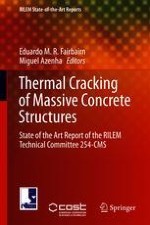2019 | OriginalPaper | Buchkapitel
3. Thermal Properties
verfasst von : Mateusz Wyrzykowski, Agnieszka Knoppik, Wilson R. Leal da Silva, Pietro Lura, Tulio Honorio, Yunus Ballim, Brice Delsaute, Stéphanie Staquet, Miguel Azenha
Erschienen in: Thermal Cracking of Massive Concrete Structures
Aktivieren Sie unsere intelligente Suche, um passende Fachinhalte oder Patente zu finden.
Wählen Sie Textabschnitte aus um mit Künstlicher Intelligenz passenden Patente zu finden. powered by
Markieren Sie Textabschnitte, um KI-gestützt weitere passende Inhalte zu finden. powered by
